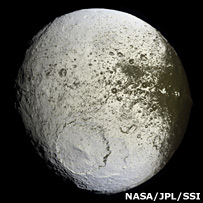'black And White Moon' Less Grey
'Black and white moon' less grey
From: http://news.bbc.co.uk/2/hi/science/nature/7035380.stm
Oct 9, 2007
Scientists think they are close to solving the mystery over why Saturnian moon Iapetus has a two-tone appearance.
The satellite has a black surface facing in the direction it travels, and a white surface bringing up the rear.
New data from the Cassini spacecraft seems to confirm Iapetus is picking up dusty material on its bow front.
But, say the mission's scientists, this material is then being warmed by the Sun's rays, making it go even darker as it loses water vapour.
With this vapour then depositing itself as ice on whiter, colder areas of the satellite, there is a process in play on Iapetus which turns up the contrast - the dark, dirty regions get even darker; and the light, icy regions get lighter.
Researchers say they still have some way to go to fully understand what is happening at this remarkable moon.
Space walnut
There is still a good deal of debate over where the dark material comes from. Some have suggested it originates on Iapetus itself; but many believe it is derived from other Saturnian moons, such as Phoebe, which have shed material.
Because Iapetus keeps the same face pointing in the direction of travel in its orbit, it is prone to pick up this material on just one side - like "bugs on a windshield".
Cassini has also offered new insights into Iapetus' other distinctive feature - the ridge that runs a near full circumference, giving the moon the appearance of a walnut in space.
Observations show the mountain ridge cannot be a young feature because it is pitted with craters. It is also too defined, say scientists, to be the result of a ring that has collapsed on to the surface.
The Iapetus observations were reported at the 39th meeting of the Division for Planetary Sciences conference in Orlando, Florida.
The Cassini-Huygens mission is a cooperative project of the US space agency (Nasa), the European Space Agency (Esa) and the Italian Space Agency (Asi).



